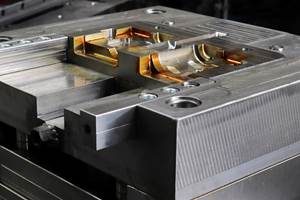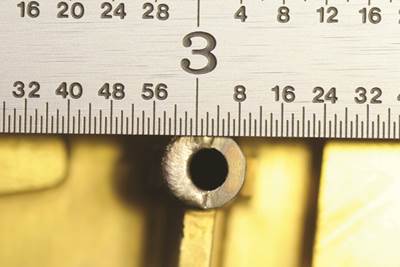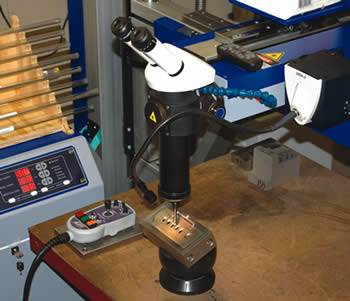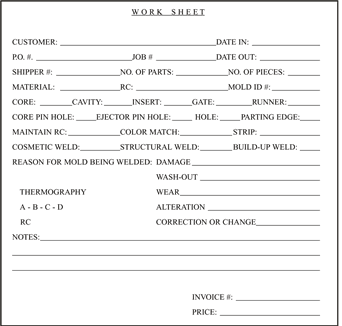The Right Rods for the Best Finish, Color and Texture Match
The same rod cannot achieve all welds as well as color and texture match. The key is finding out exactly what the rod is capable of by looking at the chemical and physical tests.
I feel sorry for the toolroom that has the guy who can physically weld, but only has one rod and is trying to do everything with that rod. I’ve seen shops that have a rod they use on everything. It’s a nightmare for them because they are creating more problems than they are solving. I would recommend one seek a professional weld shop to perform welds, but if that isn’t possible, it is important to know there are a variety of rods out there—each with different capabilities.
To find out these capabilities one needs to test them. We actually make our test samples up ahead of time—they are already heat treated and drilled. Stacks of them are waiting as we cannot test on our customers’ molds. We do this testing so that when a problem comes up, we can handle it.
Breaking Down Welds
We break all welds into three categories: cosmetic, structural and buildup—cosmetic being the most difficult. A mold shop with one type of H13 rod is trying to achieve all of these welds with the same rod, as well as a color and texture match, and it just can’t be done. One needs to find out exactly what the rod is capable of. But that information is only pertinent to the material it is tested on.
To test, take three 2X4 half-inch steel plates and drill eight holes in them (3/8 inch in diameter) 1/8-inch deep that are evenly spaced on each plate. Heat the first plate to 200oF and weld one hole with the amperage the welder is comfortable with. Then, place it back in the oven and heat it up to 250oF, pull it out, and weld the next hole. Continue raising it 50oF for each hole until the eight holes are completed.
Then, place it back in the oven and allow it to cool 50oF per hour until it reaches ambient temperature. Surface grind it and polish it, and note that many of these polishes are different because the heat-affected zone changes as the steel is preheated. Now, repeat the process, but lower the amperage 20 percent on the next plate, and follow the same procedures. Grind and polish that. For the third plate, lower the amperage 10 percent and repeat the process.
One will discover a correlation between the two: it shows that preheat alters the color match and the amperage alters the color match. In other words, every type of H13 tool steel welds slightly different than another one. Some manufacturers make two or three different types of H13, so using one rod for all welds is like trying to be a mechanic with one wrench. It can’t be done. A variety of rods are needed.
The three samples that the welder just ran should be sent out for texture. Each one of these holes needs a stamp number next to it so when the welder comes back to it he knows what process he used to achieve that finish. It’s all about learning. If all the welder has is one or two rods, he needs to know what they will do, and the only way he will know that is to test them.
For example, if one uses Brand X H13 material all of the time, run these tests, do the polish, and after the polish do the texture, when one welds Brand X with the process that gave the best finish, it will repeat year after year. But if one starts using Brand B, the tests have to be run again. Shops don’t want to do this because it gets really involved, but it is what’s necessary in order to know what the rod is capable of.
Chemical and Physical Tricks
Once the welder has obtained the very best finish he can get in polish and the very best texture, there are a few tricks he can do to improve the process even more. There are only two ways to achieve proper color match—through chemical and physical means. Chemical is the welding rod and the gas mixture. Physical is the physical act of stirring the molten pool with pulse from the welding machine or using a vibratory unit.
The welder can change brands of H13 welding rods and repeat the test. Then, he can start playing with gas mixtures. By adding a little bit of helium to the gas mix he will begin to see a difference in the weld, which will change the appearance of the weld by inducing AC background current while he is welding DC. This will give him a scrubbing action to reduce impurities while welding. These are the chemical tricks which will change the way it polishes. There are many different gas mixes to look into.
A physical trick is to add pulse to the weld. Pulse will agitate the pool or stir it. By stirring the pool it helps blur the fusion line. What makes a weld show up different is because there is a total differential between the parent material and the weld—it looks like somebody inserted a plug and the plug is shiny. If the welder can blur that fusion line it will help hide the weld and the way to blur it is through the pulse or a gas mixture, or a physical (mechanical) means.
One also can shake that pool with a pulse weld or with vibratory means, but this is generally only done in a professional shop. It is good to know what is available even if a mold shop wouldn’t do this. There is a vibratory stress relief unit manufactured for stress relieving molds other than thermal; it uses vibration. The mold is mounted directly to a vibratory unit. Halfway through the cycle, the weld is started and the vibration shakes molten pool and blurs the fusion lines. The welder has to be really careful because he can actually set up a crystalline structure.
The Challenges of Repair: Unknown Material
If the welder wants to achieve a good texture, he has to know what the rod is capable of. The only way to know this is to run it through this battery of tests. These tests are only good for that rod with the specific material one is testing. If the welder is dealing with four or five different H13s, the test needs to be run for each one. The problem comes when one is doing repair. That means the welder doesn’t know who made the material that is coming through the door, so he better go to a professional welding shop.
Summary
While most mold shops have one or two types of A2 rod or H13, I carry 11 different H13 rods and sometimes still have trouble getting the match desired. It is important to understand if one is manufacturing molds and using only one type of H13 steel and one type of rod there are things that can be done to improve the way that rod welds.
A spectrograph analysis can be performed. It leaves a quarter-inch diameter area that looks like it has been sandblasted. A tungsten arc is struck against the back and the light that comes off the spectrograph is red and it gives the composition of the material.
Another means of identifying material called thermography, which is a heated probe. Another method, called eddy current, uses a magnetic field. These won’t tell anyone what the steels are, they are simply sorting devices.
We have over 780 tubes of welding rods and I still have trouble getting matches. And every time I buy a new steel I have to run it through a battery of tests to know what it is capable of, and I have to run it on many different manufacturers. We do a lot of testing here since I can’t experiment on a customer’s tool. I need to know what it will do before I get it here.
Even if the welder was given samples and knows what steel he is dealing with, he still needs to know the chemistry. Not all H 13s are created equal. That’s why some manufacturers make three kinds. Maybe someone is looking for a higher polish or a higher wear rate. Bring the manufacturer of the steel on board. Tell them the shop is buying their steel and it will have to have some repair done to it, and ask them what they recommend for a rod? Then, call the manufacturer of the rod, and ask what preheat they recommend? What post heat? With practice, your shop will get there. If the shop welder feels he is in over his head, seek a professional welder.
Related Content
Laser Welding Versus Micro Welding
The latest battle in finely detailed restoration/repair of mold materials.
Read MoreWhat is Scientific Maintenance? Part 2
Part two of this three-part series explains specific data that toolrooms must collect, analyze and use to truly advance to a scientific maintenance culture where you can measure real data and drive decisions.
Read MoreHands-on Workshop Teaches Mold Maintenance Process
Intensive workshop teaches the process of mold maintenance to help put an end to the firefighting culture of many toolrooms.
Read MoreHow to Use Diffusion Bonding to Optimize a Mold’s Thermal Performance
Joining dissimilar metals has tremendous potential for conformal cooling, but to successfully use diffusion bonding, a mold builder must understand the complexities of the interface and its effect on the chemical and thermo-mechanical properties of the bond.
Read MoreRead Next
Laser Welding Versus Micro Welding
The latest battle in finely detailed restoration/repair of mold materials.
Read MoreIn-House Welder Saves Time, Boosts Productivity and Creates New Market Opportunities
Laser welding system increases moldmaker’s ability to meet its customers’ cost and timing demands while also increasing efficiency and output, and creating niche opportunity for mold repair outside its doors.
Read MoreThe Value of a Shop’s Welding Policy
To put the appropriate welding policy in place, you need to choose the right welder—someone who is familiar with tool steel and has a working knowledge of molds.
Read More
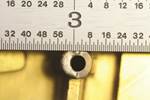






.jpg;maxWidth=300;quality=90)




_300x250 1.png;maxWidth=300;quality=90)











